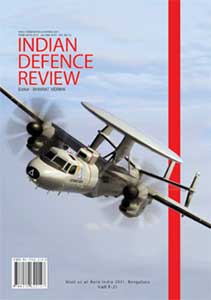Inadequacies of Defence Policies
The fact that the Indian State is yet to mature in its military-specific policy making needs no emphasis. The most visible example of this limitation is that most of the rules and procedures applicable to the armed forces, barring certain provisions enshrined in the Constitution, are the same, if not more restrictive, as those applicable to other ministries/departments. Thus modernisation projects – force-structure, upgrade of hardware and personnel management – are stymied to an extent that the state’s military preparedness as well the cost to its exchequer stand adversely affected — a situation that does not bode well for a nation seized by inimical forces from within and without on one hand, and its people struggling at the end of survival ladder on the other. Some examples of this dichotomy, fostered by both the civilian as well as military hierarchy are indicative:-
| Editor’s Pick |
Force Structure. Redundant establishments, obsolete units, imbalanced formations and deficiency in cutting-edge junior leadership abound, while force-restructuring to build up of wholesome battle-capability remain stuck in the quagmire of systemic bondages that deter progress. Thus we have depots with little work load, units saddled with men and material suited for warfare of the 1970’s, fighting formations with voids in modern all-arm composition and crippling deficiency in battle leadership. Restructuring of forces and upgrade of military hardware do not fructify in isolation. When they do; it is usual to find one part of the indented system passing muster of the reorganisation and acquisition process that is designed to deny rather than facilitate, while it’s corresponding accessories are stuck due to ‘procedural hurdles’. The fallouts are disconcerting: the basic criteria of ‘balance in composition’ in terms of firepower, mobility, engineering, information technology and logistics, remains unfulfilled in field formations while units are hard put to find officers to lead men under fire. In absence of due integration of the wholesome elements of combat, usability of the force in war remains stymied, as indeed so remains the returns from high investment in military establishment.
Indeed, the situation did attract attention and much efforts are being made being to ameliorate it, yet there is a long way to go before the Indian Army can be stated to be fully cost-efficient.
Military Hardware. Upgrade of military hardware had been reduced to a charade of knee-jerk weapon procurement, ineffective defence research, shackled defence industry and restrictive rules and procedures — the unproductive burden being borne by the soldiery and the national exchequer. Indigenous development and production of military hardware is conditioned by the objectives of the scientists, bureaucrats, auditors and labour unions rather than the needs of the military establishment. Pressure of maintaining non-productive departments, factories and establishments overrides military reason and decision of the DRDO to develop the indented hardware, with no accountability in terms of quality or time-line, supersedes the soldiery’s need to be able to carry out its mandate with fair chances of success and longer life.
Thousands of crores of capital outlay for military procurements are surrendered year after year, unspent in the face of archaic procedures, shrouded in endless controversies, manipulated by vested interests and subjected to political mudslinging, while probity of the process, essentially to thwart insinuations from inimical parties, subsumes the intended goals of modernisation. Army’s most crucial weapon and equipment upgrades are thus so delayed that these are routinely overtaken by new developments even before these can fructify, setting the clock back by decades besides inviting mind boggling cost overruns.
Thus the Army lands up with guns sans corresponding target acquisition systems, weapons minus night fighting capability, tanks without transporter back up and soldiers denied adequate protective gear. Indeed, the situation did attract attention and much efforts are being made being to ameliorate it, yet there is a long way to go before the Indian Army can be stated to be fully cost-efficient.
 Military Infrastructure. Strategic build-up – road building, revamp of base facilities and relativity of production-lines with the consumption-scales etc have to proceed at the same pace as of civil projects, there being no special dispensation from restrictive procedures and obligations; even an auditor, tehsildar or workers’ union can hold up progress after the burden of numerous environmental, legal, revenue and social stipulations are overcome after decade-long struggle. There is no dispensation for such strategic projects; time and cost over-runs are mind boggling. Strangely, only the Army is expected to deal with these numerous hurdles, as if the mandate of military preparedness is Army’s burden, not that of the state.
Military Infrastructure. Strategic build-up – road building, revamp of base facilities and relativity of production-lines with the consumption-scales etc have to proceed at the same pace as of civil projects, there being no special dispensation from restrictive procedures and obligations; even an auditor, tehsildar or workers’ union can hold up progress after the burden of numerous environmental, legal, revenue and social stipulations are overcome after decade-long struggle. There is no dispensation for such strategic projects; time and cost over-runs are mind boggling. Strangely, only the Army is expected to deal with these numerous hurdles, as if the mandate of military preparedness is Army’s burden, not that of the state.
Continued…: Indian Army: Demilitarisation and Civilianisation – II




